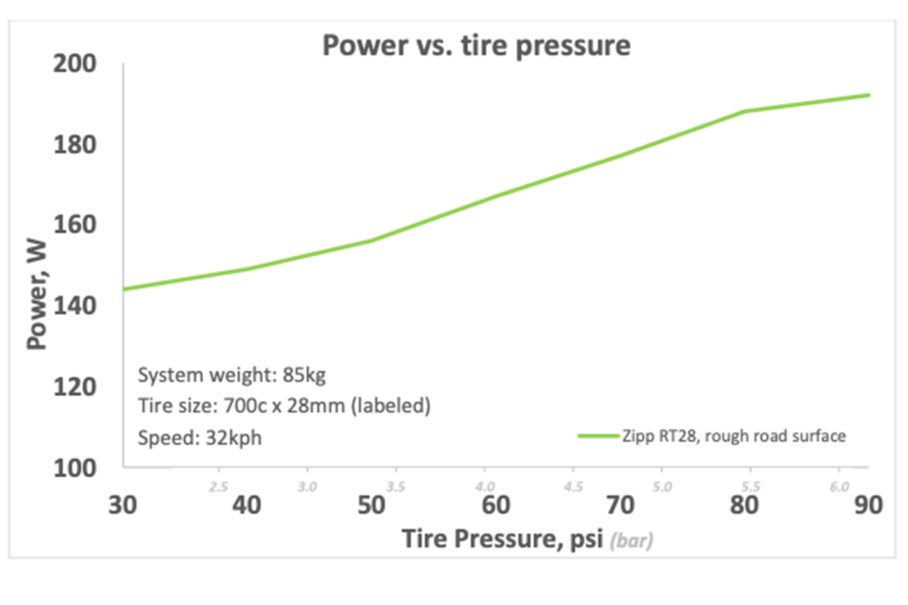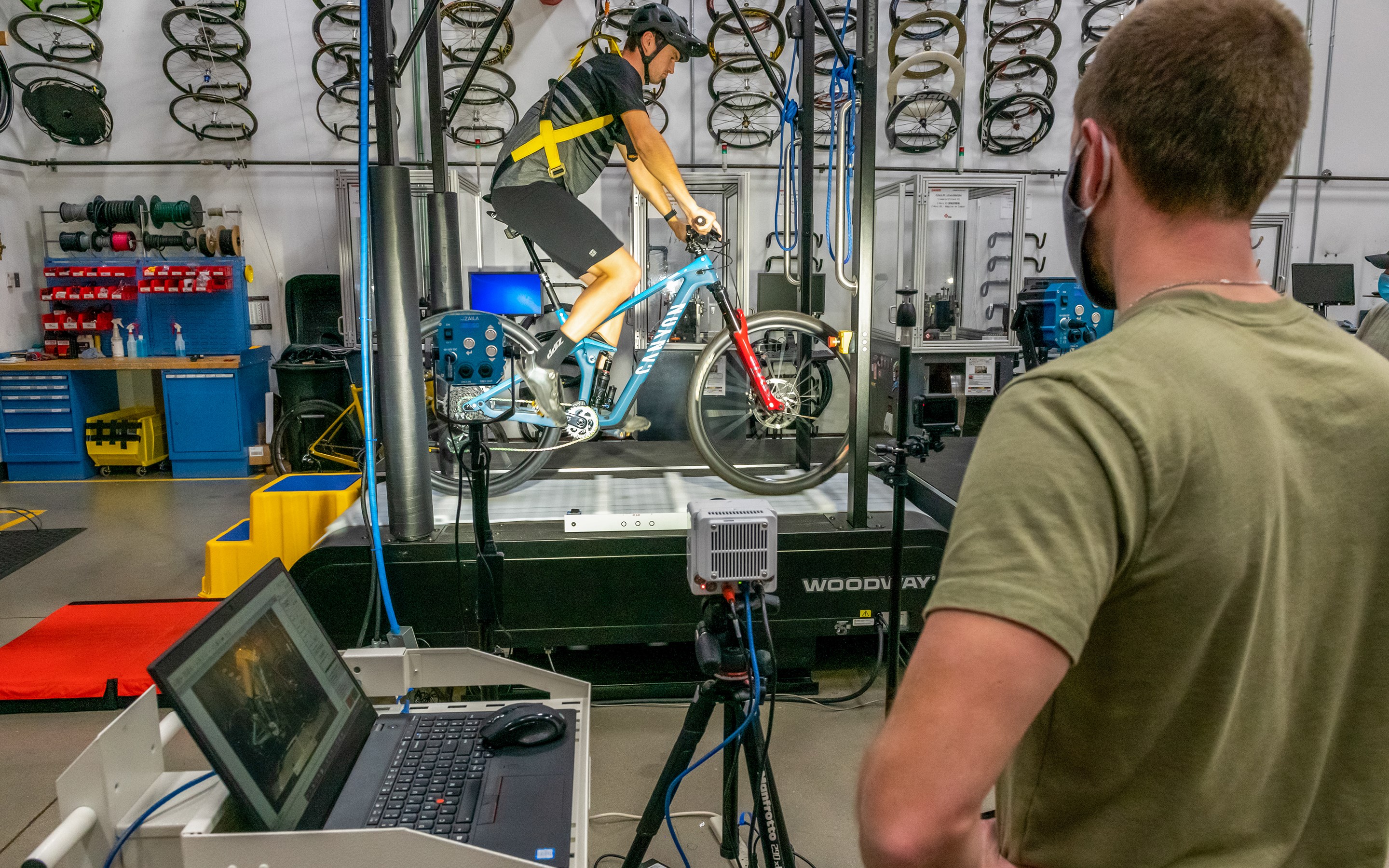LIFE ON THE ROLLINGROAD
Zipp’s test rig proves Total System Efficiency, but it’s no easy ride.
Pro mountain biker and SRAM employee Jason Blodgett learned a practical lesson from his time in the Zipp test lab in Indianapolis: “Wear gloves when riding on the RollingRoad!”
It’s a rough road by design.
Zipp engineers created a high-tech bike-treadmill, dubbing it the “RollingRoad™,” inside the Indianapolis test lab to study and verify Zipp’s Total System Efficiency approach for wheel design. The RollingRoad is a bit like rollers modified by mad scientists: Harnessed riders rattling over bumps simulating gravel, potholes, crumbling pavement or (of course) cobblestones.
The goal is to analyze the efficiency of different wheel-tire configurations over various surfaces in the controlled environment of the lab. The RollingRoad was crucial in the development of Zipp’s Total System Efficiency approach to wheel design and its focus on wider tires running at lower tire pressure.
Zipp’s Total System Efficiency focuses on overcoming the four barriers to speed: Wind resistance/aerodynamics, gravity/weight, rolling resistance, and vibration loss. The RollingRoad is especially effective at evaluating two of those: rolling resistance and vibration loss.
Rolling Road test: The power of vibration damping
The tests require a high level of supervision to ensure safety and to collect all relevant data. Speeds on the RollingRoad go up to about 20 mph. The riding surface also can incline or decline to simulate hills. Zipp engineers and test-lab techs affix the different-sized bumps. “It’s a full bike and rider,” said Troy Howell, senior test technician in the Indy lab. “We have them harnessed to a gantry surrounded by three engineers. We want a minimum of three people running the test.”
Engineers then study high-speed video footage and power meter data from riders on the RollingRoad. “That helps us measure and slow everything down so we can see things like rider fatigue, leg shake, see how much the bar and the stem are moving, the fork. It helps us hone in and slow everything down. You can see and get a good visual as to what’s going on,” Howell said.
Zipp Advanced Development Engineer David Morse sees the RollingRoad as a new tool to study an emerging focus of bike science: measuring riding efficiency relative to surface roughness and tires. “This is our first set of eyes to understand what the potential is gained from optimizing your tire on a certain surface,” he said.
The RollingRoad was instrumental in the development of Zipp’s new generation of wheels featuring wide internal rim widths and hookless tire-rim interface designed for wide tires with lower air pressure. Morse documented the Total System Efficiency approach in a white paper revealing several test results from RollingRoad research.

DATA FROM THE ROLLINGROAD
The data represented in the graph above provides good context for why the effects of vibration loss are important to consider when striving to maximize speed on a bicycle. There was a 48 watt decrease in power required between 90 psi (6.12 bar) and 30 psi (2.04 bar). While this graph indicates that tire pressures at or below 30psi (2.04bar) with a 28mm tire are the most efficient over a surface of equivalent roughness, other factors such as tire, wheel, and handling integrity limit the feasibility of using such low pressures. The data is from our RollingRoad testing and captures power losses from rolling resistance, vibration loss, and drivetrain while traveling 32kph over a simulated poor-condition asphalt (green line in the dynamic response plot of Figure 4 above).

MEET THE ROLLINGROAD RIDERS
Lewis Henrickson (above) RollingRoad test rider and SRAM engineering technician
What products did you test on the rolling road?
I’ve tested legacy 303, and 404, as well as current 303, 353, 404, 454, and Moto (3ZERO and 101 XPLR) wheels.
What were the goals of the tests – what specific road obstacles did you face on the treadmill?
For the wheels, most of the tests were to compare efficiencies between our old wheels and the new (Total System Efficiency) design. We would run different tire sizes and air pressures between the two, and compare the watts required to ride at 20 mph. We also attached accelerometers to the fork and bars to understand the amount of vibration translated to the rider, and how different wheels/ tires/ pressures effect performance. The tests where we have multiple wheelsets, and multiples sets of tires ends up making for a long day. In the comparison between the old 303 and the new 303, the bumps were so difficult that it was hard to see.
What was it like to ride the Rolling Road? Was it tricky to get a feel for it? Harder than you expected?
At first, it was a bit tricky. You must learn to trust the harness, and the ropes attaching you to the frame of the treadmill. When I started, I would hold onto the handle of the treadmill until I was up to a fast enough speed to pedal, now I just dangle on the harness like I’m in the circus or something. My favorite part is trying to see how far I can let the rear wheel fall off the back of the treadmill before I freak out and start pedaling, it really messes with your mind.
Lower pressures, and larger tires. Comfort equals speed!
–Lewis Henrickson
What did you learn from the experience?
The biggest take-a-way I have was after doing a bunch of testing with Dave Morse. We had three or four of the same tire, but in different sizes, and we would test them at different pressures starting at 70 psi and working our way down to 30 PSI. We recorded the power required for me to ride at 20mph in each configuration. It really opened my eyes to the watt savings at lower pressures. On the road a tire at lower pressures may seem “too soft” and the perceived effect is that you’re riding slower because of it, but after doing the research with Dave, I had actual numbers staring me in the face telling me that if I drop my current pressure by as little as 10 psi, I would be faster.
Anything else about the Rolling Road that stood out to out?
It’s a great tool, and we are only scratching the surface as to what we can do with it.

Jason Blodgett (above) RollingRoad test rider and SRAM Technical University Coordinator
What products did you test on the rolling road?
Zipp 101 XPLR.
What were the goals of the tests – what specific road obstacles did you face on the treadmill? The goal was to test vibration damping of the 101 XPLR wheelset vs competitors’ products as well as 303S and 303 Firecrest. The treadmill had large blocks placed onto the track to simulate rough gravel roads.
What was it like to ride the Rolling Road? Was it tricky to get a feel for it? Harder than you expected?
It is slightly difficult to get rolling and up to speed but once going it felt quite like riding rollers. Riding in a harness was also a first for me, but it quickly disappeared once the treadmill got up to speed.
What did you learn from the experience?
This could either be about the products you were testing, or about the concepts we were testing. For example, Lewis maybe learned about the importance of vibration damping… During this specific test we found valuable data reducing vibrations back to the rider in a specific gravel setting with large bumps placed on the treadmill. This data allowed our engineers to fine tune the product even further to create the best TSE for gravel applications.
I found that the faster the speed of the treadmill went the less effect it had on me, as a rider. Taking this outdoors, I found the control of the 101 XPLR wheel to inspire confidence to ride faster though the rough sections.
–Jason Blodgett
Dig the science? Take a deep dive below.
TSE White Paper
Listen to Zipp Speed Podcast on the Test Lab and RollingRoad.
Photos by Joe Vondersaar